1 课程目标
• 了解 GBase 8c 分布式执行计划的分类及使用
• 了解 GBase 8c 语句的执行流程
• 介绍 explain 语法
• 介绍分布式执行计划的分类及示例
• 备注:课程内容仅适用于分布式模式
2 SQL执行流程
解析器
✔词法分析:从查询语句中识别出系统支持的关键字、标识符、操作符、终结符等。
✔语法分析:根据SQL语言的标准定义语法规则,使用词法分析中产生的词去匹配语法规则,生成对应的抽象语法树。
✔语义分析:对语法树进行有效性检查,检查语法树中对应的表、列、函数、表达式是否有对应的元数据,将抽象语法树转换为逻辑执行计划。
优化器
✔基于代价的查询优化(Cost Based Optimization,CBO):对SQL语句所待选执行路径进行代价估算,从中选择代价最低的执行路径作为最终的执行计划。
✔基于机器学习的查询优化(AI Based Optimization,ABO):收集执行计划的特征信息,借助机器学习模型获得经验信息,进而对执行计划进行调优,获得最优的执行计划。
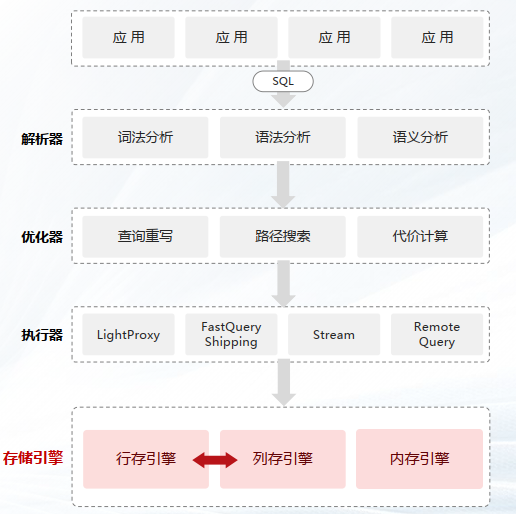
3 Explain——执行计划
Explain 语法将显示 SQL 语句所引用的表会采用什么样的扫描方式,如:简单的顺序扫描、索引扫描等。如果引 用了多个表,执行计划还会显示用到的 JOIN 算法。基本语法与常用参数:
EXPLAIN [ ( option [, ...] ) ] statement;
where option can be:
ANALYZE [ boolean ] | ANALYSE [ boolean ] | -- 显示实际运行时间和其他统计数据
VERBOSE [ boolean ] | -- 显示额外的详细信息
COSTS [ boolean ] | -- 包括每个规划节点的估计总成本,以及估计的行数等信息
DETAIL [ boolean ] | -- 打印数据库节点的信息
TIMING [ boolean ] | -- 包括实际的启动时间和花费在输出节点上的时间信息
PLAN [ boolean ] | -- 是否将执行计划存储在plan_table中。
FORMAT { TEXT | XML | JSON | YAML } -- 指定输出格式。
4 分布式执行计划
—4.1 分布式执行计划类型-LightProxy
LightProxy
• 执行计划只涉及一个DN节点,直接将 sql 语句发送到 dn 执行
• 单个DN即可完成结果的获取,常见于点查、精准查询场景。
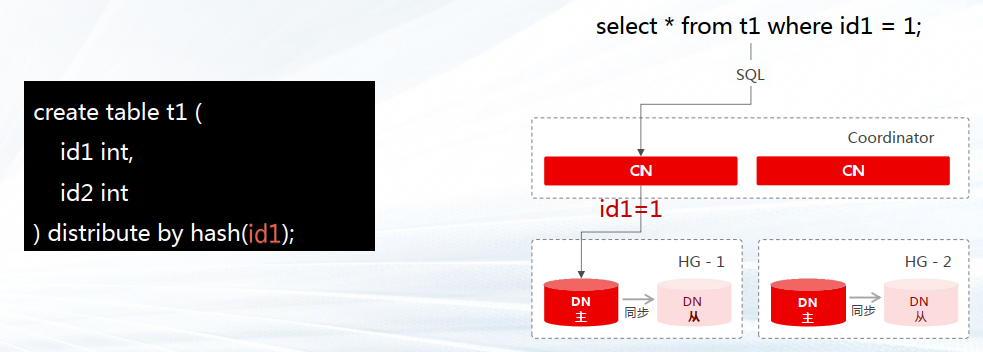
—4.2 分布式执行计划类型-FQS
FQS (Fast Query Shipping)
• 计划可以涉及多个DN节点,但在执行过程中,DN节点之间无数据交 互;
• FQS 会对 sql 进行适当重写,通过remote query执行;
select * from t1,t2 where t1.id1=t2.id1; ——>
SELECT t1.id1, t1.id2, t2.id1, t2.id2 FROM public.t1, public.t2 WHERE ((t1.id1 = t2.id1));

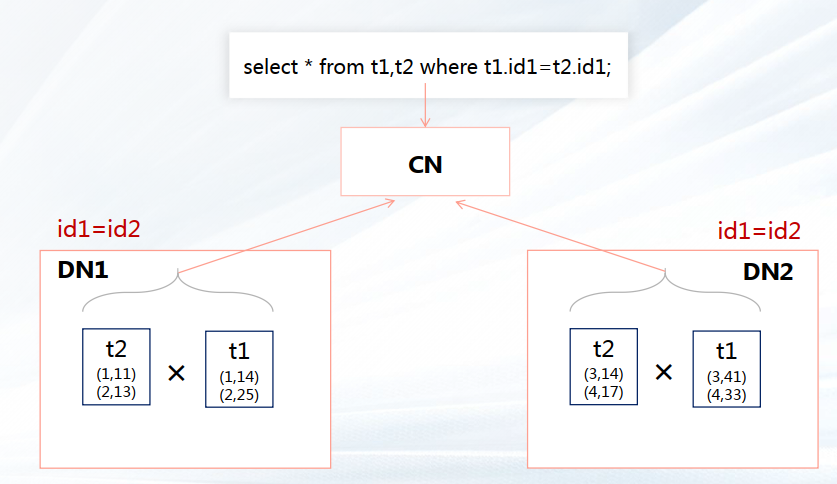
—4.3 分布式执行计划类型-Stream
Stream
• 由 cn 生成执行计划,将执行计划发送到 dn,dn 按照接收到的计划执行相应算子,cn 收集 dn 的执行结果,进行处理后做最后输出;
• Stream 算子类型:gather、redistribute、broadcast
‒ gather:cn 将本算子以下的计划发送的其他节点,收集汇总dn的执行结果;
‒ broadcast:执行broadcast时,dn将查询到的数据广播到所有其他dn节点,在执行过程中,拥有两种角色,consumer、producer,
consumer:接受producer发送的数据;
producer:新启动streamworker线程作为producer,将扫描到的所有数据,广播到所有 consumer(本dn和其他dn);
‒ redistribute:过程和broadcast类似,但producer在发送数据根据指定的key选择发送发送到哪个consumer;
‒ 当 broadcast 与 redistribute 均能实现查询时,倾向于将小表做广播,大表做重分布。
—4.4 例1:select无连接条件
• cn将stream(gather类型stream) 以下的计划(nested loop)发送的 dn,由dn执行;
• 接收cn计划的dn执行stream (broadcast或redistribute)时,作为consumer,启动stream worker 线程作为producer,执行此stream 以下的计划(seq scan public.t1);
• producer将获得的数据,按照 stream类型,发送到各个dn的 consumer。

示例图
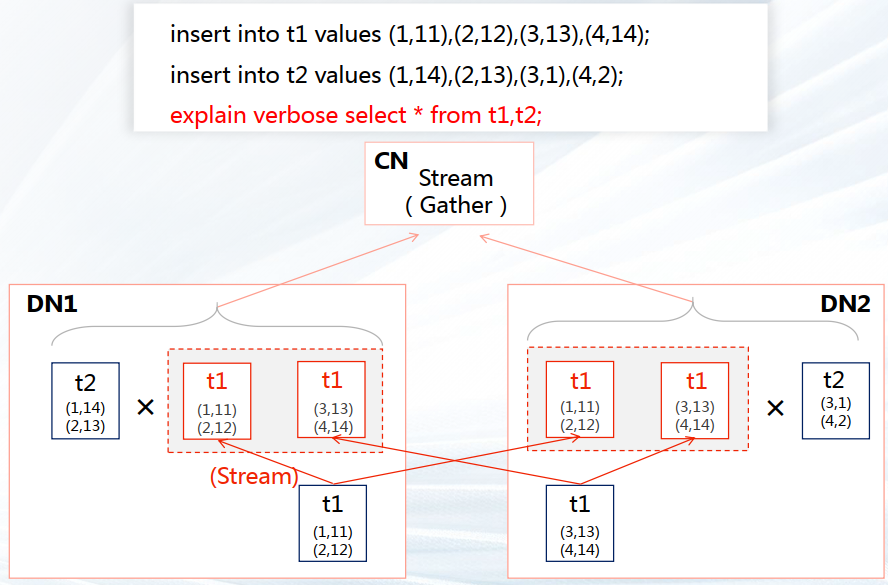
—4.5 例2:select连接条件为分布列和非分布列
• 连接条件为t1.id1(分布列)与 t2.id2(非分布列)时,将t2表 数据按照id2在dn上做重分布。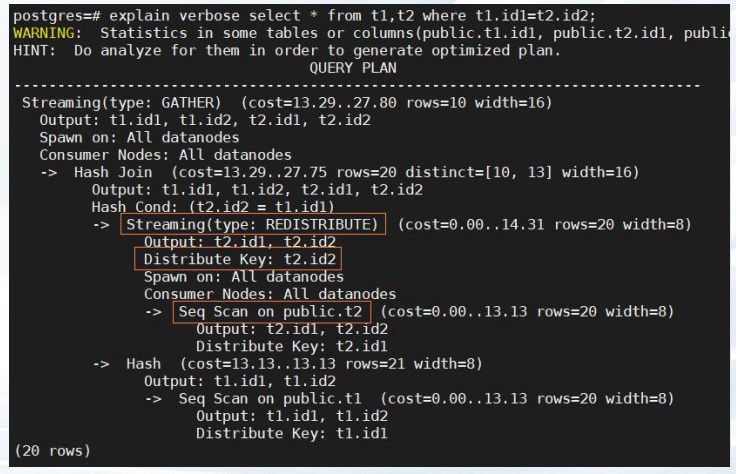
示例图
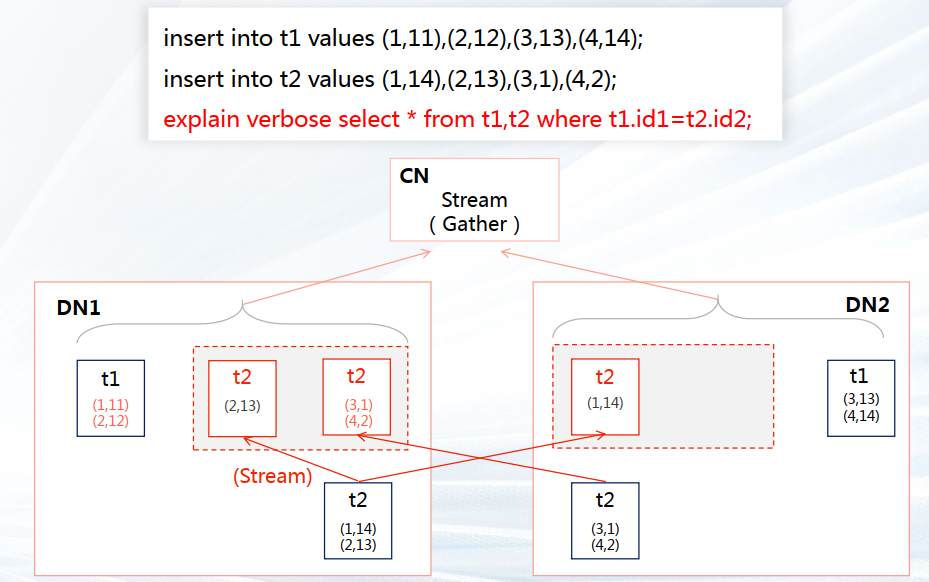
—4.6 例3:select连接条件为非分布列
• 当链接条件均为非分布列时,通过广播和重分布均能实现链接,表规模较小时,倾向于广播,规模较大时,倾向于重分布。

—4.7 例4:update连接条件为分布列
• update t1 时,连接条件为t1.id1(分布列)与t2.id1(分布列),不会进行重分布或广播。
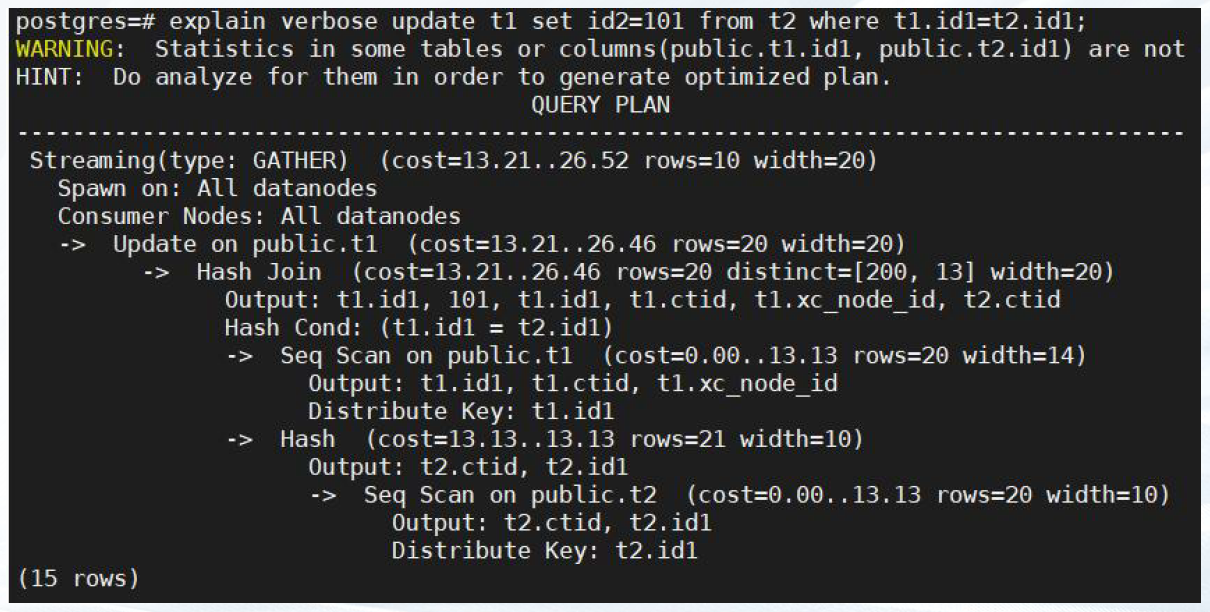
—4.8 例5:update连接条件为分布列与非分布列
• update t1时,连接条件为t1.id2(非分布列)与t2.id1(分布列),更新的是t1表,不能广播或重分布t1表。
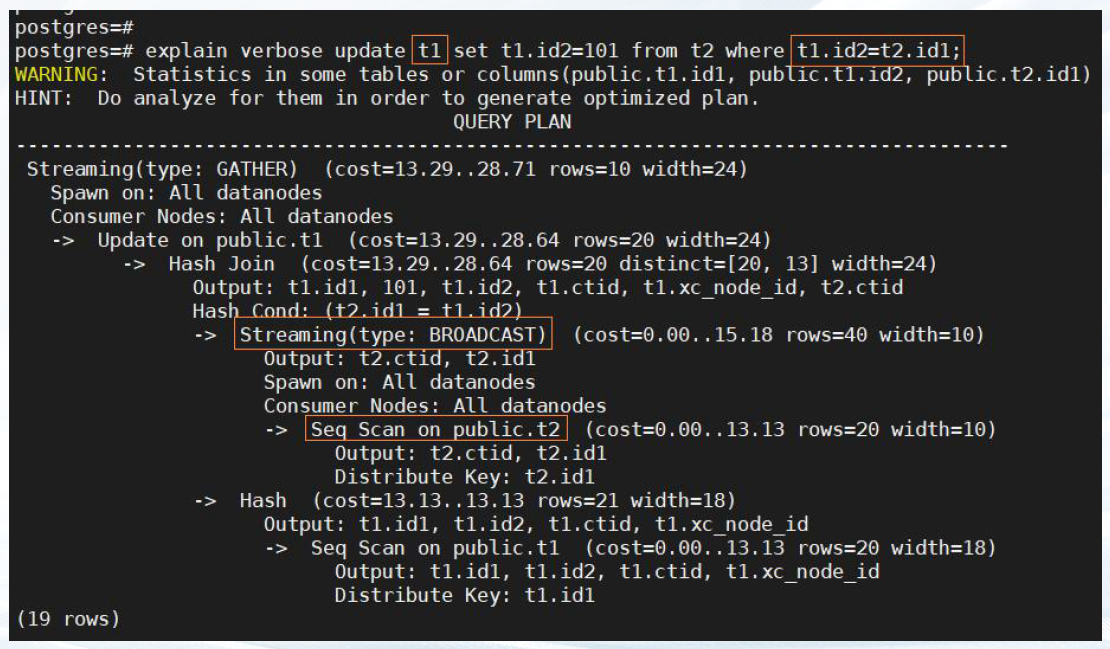
示例图
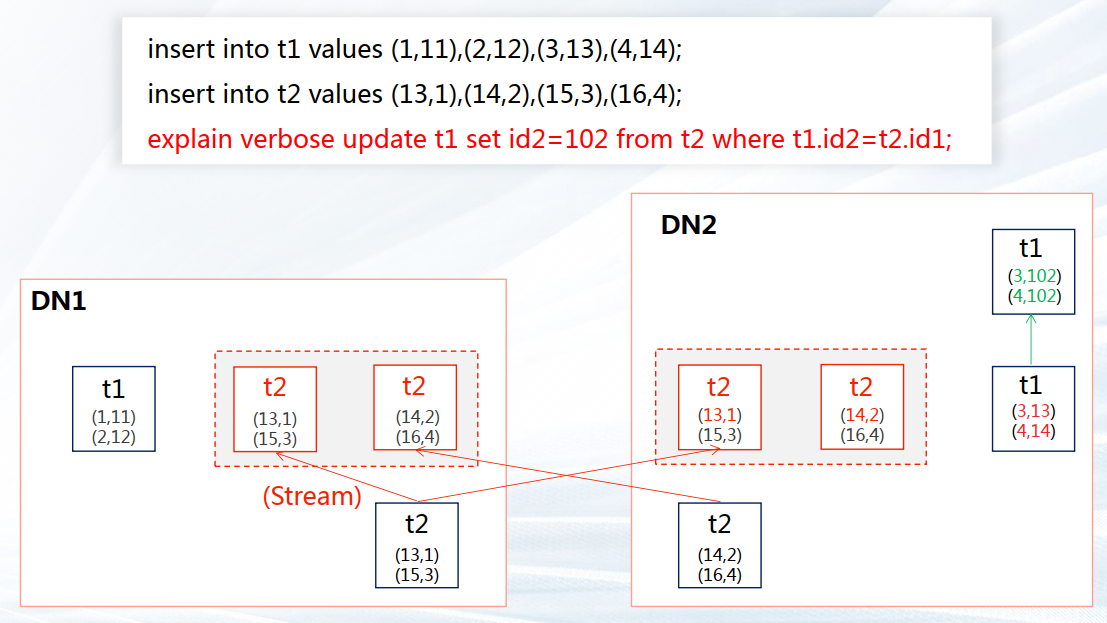
5 分布式执行计划类型-Remote query
Remote query
• Remote query 计划将查询语句发送到 DN 节点,在 CN 收集执行结果;
• 不支持 Stream 计划时,通过 Remote query 将数据收集到 CN,在 CN 完成相关操作;
• update 带有 returning 语句,并存在两表连接,不支持 stream 计划,CN 通过 remote query 从 DN 获取两表数据,在 CN 完成连接操作,根据连接结果构造最终 update 语句,通过remote query下发 DN。
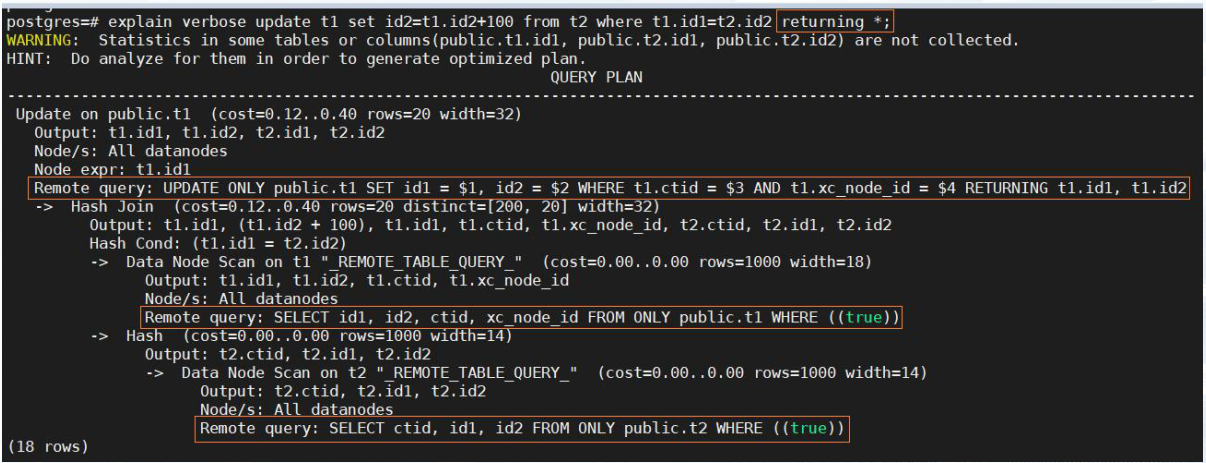
示例图
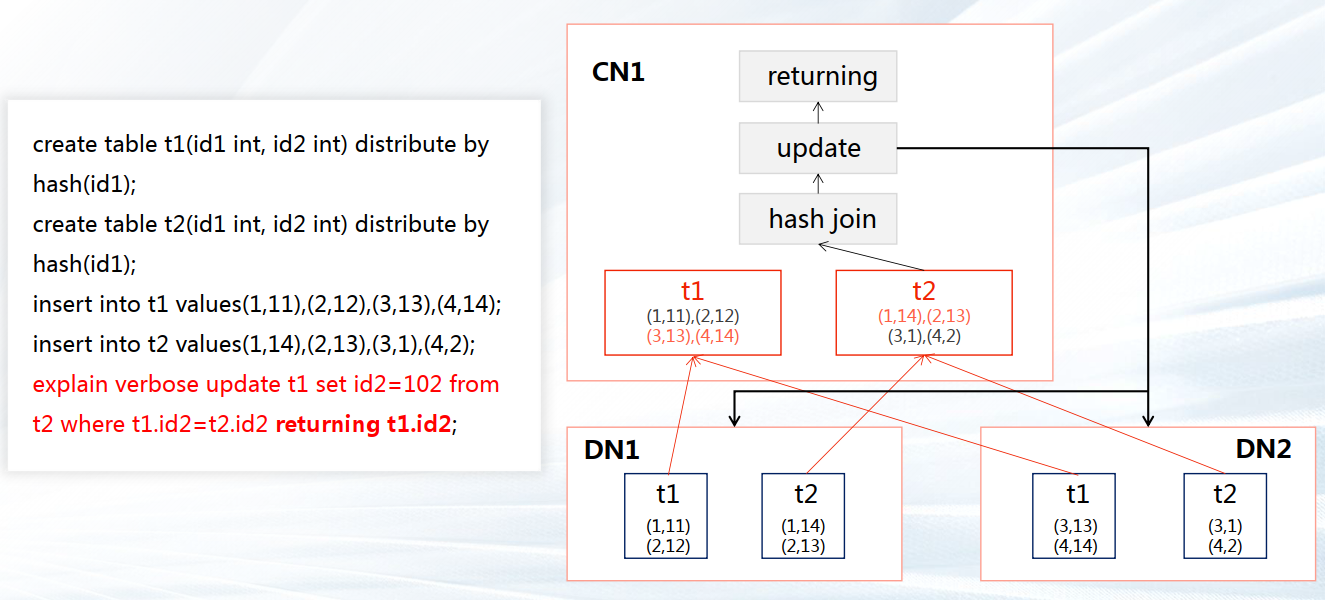
6 操作示例
/* ***************************************************** 以下命令为 linux 命令 ************************************************** */
--- su 命令切换到数据库用户 gbase,如果当前用户已为 gbase 用户,则忽略此条命令。
su - gbase
--- linux 命令:gsql 使用默认端口 连接数据库
gsql -d postgres -p 5432
/* ****************************************************** 以下都为sql命令 ******************************************************* */
--- gsql 连接成功后,将以下 sql 逐条在gsql中执行,进行验证。(若使用dbeaver工具,dbeaver 连接成功后,复制粘贴以下sql 执行进行验证)
/*************************************************/
/***** 1. LightProxy ******/
/*************************************************/
--- 创建表
create table t1 (
id1 int,
id2 int
)distribute by hash(id1);
--- 插入数据
insert into t1 select generate_series(1,100),generate_series(1,100);
--- 执行explain
explain analyze select * from t1 where id1 = 1;
---
--- QUERY PLAN
--- -----------------------------------------------------------------------------------------------
--- Data Node Scan (cost=0.00..0.00 rows=1000 width=8) (actual time=1.552..1.553 rows=1 loops=1)
--- Node/s: dn1
--- Total runtime: 1.628 ms
--- (3 rows)
/*************************************************/
/***** 2. FQS (Fast Query Shipping) ******/
/*************************************************/
--- 创建表t1,分布列为id1
drop table if exists t1;
create table t1 (
id1 int,
id2 int
)distribute by hash(id1);
--- 创建表t2,分布列为id1
drop table if exists t2;
create table t2 (
id1 int,
id2 int
)distribute by hash(id1);
--- 插入数据
insert into t1 select generate_series(1,100),generate_series(1,100);
insert into t2 select generate_series(1,100),generate_series(1,100);
--- 执行explain
explain analyze select * from t1,t2 where t1.id1=t2.id1;
--- QUERY PLAN
--- --------------------------------------------------------------------------------------------------
--- Data Node Scan (cost=0.00..0.00 rows=1000 width=16) (actual time=4.112..5.206 rows=100 loops=1)
--- Node/s: All datanodes
--- Total runtime: 5.377 ms
--- (3 rows)
/*************************************************/
/***** 3. Stream ******/
/*************************************************/
--- (1)select 连接条件为分布列和非分布列
explain verbose select * from t1,t2 where t1.id1 = t2.id2;
--- QUERY PLAN
--- -----------------------------------------------------------------------------
--- Streaming(type: GATHER) (cost=1.04..2.28 rows=1 width=16)
--- Output: t1.id1, t1.id2, t2.id1, t2.id2
--- Spawn on: All datanodes
--- Consumer Nodes: All datanodes
--- -> Hash Join (cost=1.04..2.28 rows=4 distinct=[1, 2] width=16)
--- Output: t1.id1, t1.id2, t2.id1, t2.id2
--- Hash Cond: (t2.id2 = t1.id1)
--- -> Streaming(type: REDISTRIBUTE) (cost=0.00..1.22 rows=4 width=8)
--- Output: t2.id1, t2.id2
--- Distribute Key: t2.id2
--- Spawn on: All datanodes
--- Consumer Nodes: All datanodes
--- -> Seq Scan on public.t2 (cost=0.00..1.02 rows=4 width=8)
--- Output: t2.id1, t2.id2
--- Distribute Key: t2.id1
--- -> Hash (cost=1.02..1.02 rows=4 width=8)
--- Output: t1.id1, t1.id2
--- -> Seq Scan on public.t1 (cost=0.00..1.02 rows=4 width=8)
--- Output: t1.id1, t1.id2
--- Distribute Key: t1.id1
--- (20 rows)
--- (2)select 连接条件为非分布列和非分布列
explain verbose select * from t1,t2 where t1.id2 = t2.id2;
--- QUERY PLAN
--- -----------------------------------------------------------------------------------
--- Streaming(type: GATHER) (cost=1.24..2.48 rows=1 width=16)
--- Output: t1.id1, t1.id2, t2.id1, t2.id2
--- Spawn on: All datanodes
--- Consumer Nodes: All datanodes
--- -> Hash Join (cost=1.24..2.48 rows=4 distinct=[1, 1] width=16)
--- Output: t1.id1, t1.id2, t2.id1, t2.id2
--- Hash Cond: (t1.id2 = t2.id2)
--- -> Streaming(type: REDISTRIBUTE) (cost=0.00..1.22 rows=4 width=8)
--- Output: t1.id1, t1.id2
--- Distribute Key: t1.id2
--- Spawn on: All datanodes
--- Consumer Nodes: All datanodes
--- -> Seq Scan on public.t1 (cost=0.00..1.02 rows=4 width=8)
--- Output: t1.id1, t1.id2
--- Distribute Key: t1.id1
--- -> Hash (cost=1.22..1.22 rows=4 width=8)
--- Output: t2.id1, t2.id2
--- -> Streaming(type: REDISTRIBUTE) (cost=0.00..1.22 rows=4 width=8)
--- Output: t2.id1, t2.id2
--- Distribute Key: t2.id2
--- Spawn on: All datanodes
--- Consumer Nodes: All datanodes
--- -> Seq Scan on public.t2 (cost=0.00..1.02 rows=4 width=8)
--- Output: t2.id1, t2.id2
--- Distribute Key: t2.id1
--- (25 rows)
--- (3)update 连接条件为分布列
explain verbose update t1 set id2 = 101 from t2 where t1.id1 = t2.id1;
--- QUERY PLAN
--- ----------------------------------------------------------------------------------
--- Streaming(type: GATHER) (cost=1.03..2.07 rows=1 width=20)
--- Spawn on: All datanodes
--- Consumer Nodes: All datanodes
--- -> Update on public.t1 (cost=1.03..2.07 rows=4 width=20)
--- -> Hash Join (cost=1.03..2.07 rows=4 distinct=[200, 2] width=20)
--- Output: t1.id1, 101, t1.id1, t1.ctid, t1.xc_node_id, t2.ctid
--- Hash Cond: (t1.id1 = t2.id1)
--- -> Seq Scan on public.t1 (cost=0.00..1.02 rows=4 width=14)
--- Output: t1.id1, t1.ctid, t1.xc_node_id
--- Distribute Key: t1.id1
--- -> Hash (cost=1.02..1.02 rows=4 width=10)
--- Output: t2.ctid, t2.id1
--- -> Seq Scan on public.t2 (cost=0.00..1.02 rows=4 width=10)
--- Output: t2.ctid, t2.id1
--- Distribute Key: t2.id1
--- (15 rows)
--- (4)update 连接条件为分布列与非分布列
explain verbose update t1 set id2 = 101 from t2 where t1.id2 = t2.id1;
--- QUERY PLAN
--- ----------------------------------------------------------------------------------
--- Streaming(type: GATHER) (cost=1.04..2.64 rows=1 width=24)
--- Spawn on: All datanodes
--- Consumer Nodes: All datanodes
--- -> Update on public.t1 (cost=1.04..2.63 rows=4 width=24)
--- -> Hash Join (cost=1.04..2.63 rows=4 distinct=[4, 2] width=24)
--- Output: t1.id1, 101, t1.id2, t1.ctid, t1.xc_node_id, t2.ctid
--- Hash Cond: (t2.id1 = t1.id2)
--- -> Streaming(type: BROADCAST) (cost=0.00..1.56 rows=12 width=10)
--- Output: t2.ctid, t2.id1
--- Spawn on: All datanodes
--- Consumer Nodes: All datanodes
--- -> Seq Scan on public.t2 (cost=0.00..1.02 rows=4 width=10)
--- Output: t2.ctid, t2.id1
--- Distribute Key: t2.id1
--- -> Hash (cost=1.02..1.02 rows=4 width=18)
--- Output: t1.id1, t1.id2, t1.ctid, t1.xc_node_id
--- -> Seq Scan on public.t1 (cost=0.00..1.02 rows=4 width=18)
--- Output: t1.id1, t1.id2, t1.ctid, t1.xc_node_id
--- Distribute Key: t1.id1
--- (19 rows)
/*************************************************/
/***** 4. Remote query ******/
/*************************************************/
explain verbose update t1 set id2 = 101 from t2 where t1.id1 = t2.id2 returning t1.id1;
--- QUERY PLAN
--- -------------------------------------------------------------------------------------------------------------------------
--- Update on public.t1 (cost=0.03..0.07 rows=4 width=20)
--- Output: t1.id1
--- Node/s: All datanodes
--- Node expr: t1.id1
--- Remote query: UPDATE ONLY public.t1 SET id1 = $1, id2 = $2 WHERE t1.ctid = $3 AND t1.xc_node_id = $4 RETURNING t1.id1
--- -> Hash Join (cost=0.03..0.07 rows=4 distinct=[200, 4] width=20)
--- Output: t1.id1, 101, t1.id1, t1.ctid, t1.xc_node_id, t2.ctid
--- Hash Cond: (t1.id1 = t2.id2)
--- -> Data Node Scan on t1 "_REMOTE_TABLE_QUERY_" (cost=0.00..0.00 rows=1000 width=14)
--- Output: t1.id1, t1.ctid, t1.xc_node_id
--- Node/s: All datanodes
--- Remote query: SELECT id1, ctid, xc_node_id FROM ONLY public.t1 WHERE ((true))
--- -> Seq Scan on public.t1 (cost=0.00..1.02 rows=2 width=14)
--- Output: id1, ctid, xc_node_id
--- -> Hash (cost=0.00..0.00 rows=1000 width=10)
--- Output: t2.ctid, t2.id2
--- -> Data Node Scan on t2 "_REMOTE_TABLE_QUERY_" (cost=0.00..0.00 rows=1000 width=10)
--- Output: t2.ctid, t2.id2
--- Node/s: All datanodes
--- Remote query: SELECT ctid, id2 FROM ONLY public.t2 WHERE ((true))
--- -> Seq Scan on public.t2 (cost=0.00..1.02 rows=2 width=10)
--- Output: ctid, id2
--- (22 rows)
 MySQL学习笔记
MySQL学习笔记